
BetterCloud Vs. JumpCloud: Which ULM Tool To Choose?
BetterCloud's ULM enables your IT team to automate onboarding, mid-life cycle transitions, and offboarding processes. Meanwhile, JumpCloud's ILM primarily focuses on allowing your IT team to manage and authenticate employees' identities.
However, both the tools offer additional capabilities as well which we’ll discuss in this article. So that you as an IT manager can thoroughly assess the capabilities before making the right choice.
To determine which ULM tool is better among BetterCloud and JumpCloud, it's crucial to evaluate each tool's functionalities and assess how well it aligns with your IT team's requirements.
Let's consider the onboarding process for a new employee in an organization. BetterCloud's ULM solution offers automated onboarding capabilities, which means it can help your IT team streamline and expedite the entire process. It can automatically provision employees, grant them required access to SaaS apps, assign appropriate entitlements, and enforce security policies during the onboarding phase.
JumpCloud's ILM solution primarily focuses on helping your IT team manage and authenticate employee identities. While it can assist in granting access to SaaS apps during onboarding, its primary emphasis is on the authentication and management of user identities across various systems and applications. It ensures employees' identities are securely verified and authenticated before granting access to SaaS apps and data.
This was just a brief overview of how a tool's functionalities can bring a difference in your decision-making process. Moreover, it's important to note that choosing the right platform shouldn't rely solely on a single functionality. To make an informed decision, you need to carefully examine the distinctive features of each platform.
So, in this blog, we've differentiated both tools based on different parameters to help you decide which ULM tool will be a perfect fit.
BetterCloud Vs. JumpCloud: Comparison Based On Different Parameters
Below we've closely compared each parameter to help you determine which tool's functionalities are better for streamlining the user lifecycle management process.
1. Unique Category & Carters To Which Business Size
- BetterCloud is categorized as zero-trust networking, SaaS spend management, sensitive data discovery, insider threat management (ITM), data loss prevention (DPL), SaaS operation management, and cloud file security. Furthermore, this platform is well suited for the enterprise segment with 1000 plus employees.
- On the other hand, JumpCloud is categorized as privileged access management (PAM), single sign-on (SSO), unified endpoint management (UEM), cloud directory services, remote support, mobile device management (MDM), identity and access management (IAM), password policy enforcement. Furthermore, this platform is well suited for small and mid-market segments ranging from 50 or fewer to 1000 employees.
2. User Lifecycle Management
Both BetterCloud and JumpCloud enable your IT team to manage employee access throughout their entire organizational tenure. However, each tool has its unique way of managing the user lifecycle management process, setting them apart from each other. Let's find out how they do it.
- Eliminate the tedious, repetitive onboarding/offboarding process through automation with BetterCloud
BetterCloud streamlines the onboarding and offboarding process by eliminating tedious and repetitive tasks through advanced automation. By leveraging BetterCloud, your IT team can boost your employees' productivity while ensuring the prompt and secure provisioning of accounts from HR sources such as Workday and Bamboo HR.
How does it do all that? Well, BetterCloud enables your IT team to automate and customize the onboarding workflows according to your organization's unique requirements. Unlike other tools that merely facilitate new user creation, BetterCloud goes the extra mile by offering support for over 900+ actions, thereby reducing manual work and freeing up valuable time for your IT team to focus on other core IT activities.
Additionally, BetterCloud simplifies the offboarding process with its zero-touch approach, minimizing the steps involved in handling departing employees. Through powerful automation, BetterCloud saves time and safeguards sensitive SaaS app data during employee departures. Doing so enhances your IT team's efficiency, reducing the time required to deprovision an employee from an average of 9 hours to less than 30 minutes.
Apart from that, BetterCloud allows your IT team to mitigate security risks by minimizing errors. Also, with support for 1000+ actions and a range of best practice templates, BetterCloud helps your IT teams strategically schedule on-demand workflows that automatically revoke employee access to applications and groups and transfer files to other team members.
- Streamline the provisioning/deprovisioning process with JumpCloud’s ILM Solution
Meanwhile, JumpCloud's ILM solution simplifies and automates the management of your employees' identities and access throughout their entire tenure with your organization. Unlike fragmented processes involving multiple tools, JumpCloud's open directory platform provides a centralized and efficient approach to identity management.
By leveraging JumpCloud, your IT team can centrally manage one identity and one set of credentials per employee, ensuring a unified and secure identity creation and deactivation process and access provisioning and deprovisioning.
Furthermore, JumpCloud seamlessly integrates with established identity systems like HR tools and on-prem or cloud directories, allowing for streamlined identity lifecycle management tasks.
Also, your IT team can efficiently grant new users access to SaaS apps based on their role or department using JumpCloud's group-based access control, which includes automated group suggestions. For instance, when an employee leaves your organization, it simply suspends their account, and their SaaS app access will be automatically revoked, safeguarding confidential data and processes.
Additionally, JumpCloud offers additional layers of security, such as multi-factor authentication, conditional access policies, and single sign-on to ensure ongoing user safety throughout their employment.
With JumpCloud, you can centrally manage and automate identity lifecycle processes. The open directory platform consolidates identities from any source, allowing for holistic identity, access, and device management under a single platform. By eliminating identity sprawl, JumpCloud ensures that each new identity is seamlessly integrated into a closed directory, enabling effective and controlled access delivery.
It also allows your IT team to centrally manage all devices and their associated access, regardless of the operating system, location, or ownership (such as personal devices or BYOD vs. corporate-owned). By leveraging the same group-based permissions used for identity management, your team can provide employees with device flexibility while consistently enforcing policies and automating tedious identity lifecycle management processes.
3. Role Permissions And Conditional Access
- BetterCloud’s role permissions feature
With BetterCloud, your IT team can ensure that your employees have precisely the right level of access to SaaS apps from day one. This helps in reducing granting excessive permissions and restricting necessary access.
Furthermore, it effortlessly fine-tunes roles and permissions across various SaaS applications within your IT environment. This helps to improve overall system safety and control. With ease, your team can ensure that employees have the appropriate level of access without compromising security.
Also, with it, your team can reduce the risk of unauthorized access attempts or misuse of privileges by receiving real-time alerts. Whenever there are changes to employees' access, your team will get notified of any modifications so that they can take immediate action to address potential security risks and maintain control over your systems.
Additionally, BetterCloud simplifies the management of administrative access by making bulk modifications or automating the process. This flexibility allows your team to efficiently maintain a secure IT environment and adapt quickly to changing access requirements.
Apart from that, it reduces the risk of malicious or negligent employee actions by centralizing the management of user access and permissions across all SaaS applications. By doing so, your team can easily monitor and regulate user access, minimizing the potential for unauthorized activities and ensuring compliance with security protocols.
- JumpCloud’s conditional access feature
JumpCloud offers conditional access, enabling your IT team to adjust access requirements based on dynamic and situational properties, ensuring robust security. How does it do that?
Maintaining a strong security posture requires effective policies that govern employees' access to SaaS apps. However, relying solely on static rulesets can leave vulnerabilities. With JumpCloud's conditional access policies, your team can seamlessly control access to SaaS apps and data. For example, your team can enforce additional authentication factors or restrict access when employees are not on a trusted network or device.
Furthermore, With JumpCloud, your team can enhance security without causing headaches for end users. Implement adaptive controls that dynamically adjust security measures based on context and risk. For instance, your team can relax MFA requirements when employees log in from trusted devices, networks, and locations, providing a seamless and secure user experience.
Your team can also protect your SaaS app data by enforcing conditional access policies across all identities and effectively meet compliance requirements. JumpCloud's policies provide granular control over user and administrator access, helping your team work toward compliance with frameworks such as SOC, HIPAA, GDPR, and PCI.
4. Security And Compliance
- BetterCloud enables your IT team to streamline Compliance processes by ensuring your SaaS applications and data meet all your security standards effortlessly. Furthermore, it helps your IT teams to save valuable time by swiftly auditing potential vulnerabilities and taking safety measures to mitigate security risks. Also, with BetterCloud, your IT team gets alerts whenever there are security breaches, such as unauthorized access attempts, and enforce policies that safeguard against unauthorized exposure.Additionally, with its file security audit features, it simplifies access control, configuring user roles and fine-grained permissions for any SaaS application, automatically revoking employee access when predefined limits are exceeded.
On the other hand, JumpCloud's MFA capabilities protect your digital assets, such as SaaS apps and data, preventing unauthorized logins, and ensuring a seamless user experience. With JumpCloud MFA and JumpCloud Protect, your team can seamlessly grant secure access to employees to SaaS applications, devices, networks, and more, enhancing your security posture effortlessly. Furthermore, it lets your IT team choose from various secure methods, such as push notifications, TOTP, hardware keys, biometrics, and more. This enables them to strengthen security with contextual access policies that adjust MFA enforcement based on situational needs.Apart from that, JumpCloud's password management capabilities securely store and manage employee credentials with JumpCloud's password manager. This enables your employees to create strong, unique passwords stored locally on their devices, reducing weak password usage. Also, it helps streamline the login process with auto-filled passwords, ensuring a seamless user experience. Here’s a quick overview of BetterCloud vs JumpCloud Comparison: After going through the above parameters, you might have got an idea of which ULM tool will be more suitable. However, you can look into other efficient ULM tools, such as Zluri, that offer exquisite functionalities, helping your IT team streamline provisioning and deprovisioning processes. So what is Zluri? How does it work? Here's a quick brief.
Zluri: Your Ultimate User Lifecycle Management Solution
Zluri’s user lifecycle management platform, enables your team to automate provisioning and deprovisioning processes while enhancing the employee experience. It ensures your team grants the right level of access to essential SaaS apps to the authorized employee at the required time.
How does Zluri make it all possible? It enables your IT admin to create and customize onboarding and offboarding workflows that automate the granting, modification, and revocation of access with just a few clicks. Furthermore, as per Kuppingercole's report, Zluri also seamlessly integrates with your organization's HRMS platform, providing your team with up-to-date employee details when they are needed most.
To help you understand Zluri's capabilities better, let's take a closer look at its functionality throughout the various phases of an employee's lifecycle. By exploring how it operates during each critical stage, you'll gain a deeper understanding of this innovative platform's remarkable power and versatility.
Enables Your IT Team To Grant Right Level Access During Onboarding Through Automation
With Zluri's ULM, your team can grant access to required SaaS applications with just a few clicks so that your employees can start with their work efficiently from day one without any interruption.
How does it work? Your team can create an onboarding workflow that will automate provisioning process. So, here are the steps that your team needs to follow to create the workflow:
- Step 1: From Zluri's main interface, click on the workflow module and select the onboarding option from the drop-down list. Proceed by clicking on New Workflow.

- Step 2: Select the user for the onboarding box will appear; from there, select the employee(s) whom you want to onboard. Also, you can search for a particular employee in the search bar. Once done selecting the employee, click on continue.

Note: you can even select multiple employees; this helps onboard multiple new employees in one go
- Step 3: With its intelligent feature, Zluri would suggest some apps under recommended apps based on the employee's department, role, and seniority. Choose any of those, then execute the required action for the selected applications.

- Step 4: To execute certain actions, you need to Click on Edit Task and enter the required details. Your team can schedule the actions to execute the workflow on the day of onboarding. In order to save the actions, click on Save Task, and the actions will automatically be saved.
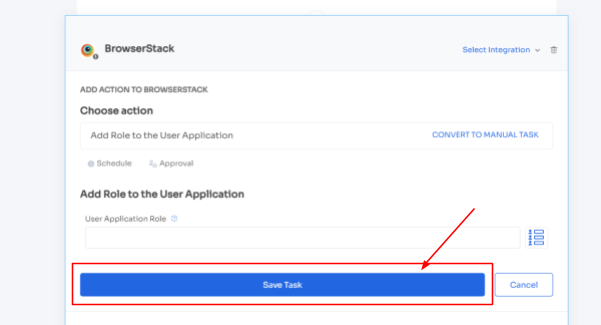
Also, your team can add your employees to channels or send an automated welcome greeting using Zluri's in-app suggestions. The actions can vary for different applications and are mentioned under recommended actions.
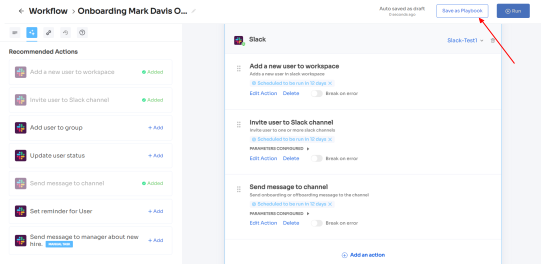
- Step 5: Finally, click on Save as Playbook to save the workflow. Then, you'll get a dialogue box with instructions to name the playbook. Add a name, proceed further by clicking on Save Playbook, and the onboarding workflow is ready.

Enables Your IT team To Seamlessly Modify Access During Mid-Lifecycle Transitions
When employees are promoted, switch departments, or relocate, they require access to new SaaS applications to begin their work. However, your IT admins need to ensure that employees receive only the necessary access permissions for their new roles while revoking their prior app access.
But how can your IT teams stay informed about changes in employee roles? Zluri seamlessly integrates with your organization's HR system, automatically retrieving updated employee data and displaying it on a centralized dashboard. With this easily accessible information, your IT admins can efficiently verify employee details and grant or remove access as needed.
But Zluri doesn't stop at benefiting your IT team, it also enhances the employee experience. Introducing the self-serve model, Zluri offers an Employee App Store (EAS), a collection of SaaS applications approved and verified by IT admins. This empowers employees with the flexibility to choose from the EAS and gain instant access to their preferred applications.
To access a desired app, employees simply submit an app access request. The IT admin is promptly notified, performs a quick identity verification, and grants secure access without disrupting the employee's workflow.
Now the ultimate question is how your employee can raise a request in EAS. Given below are the steps to submitting an access request:
- Step 1: Your employees will receive an icon on the Zluri main interface's upper right corner; click on that, and a drop-down menu will appear; from there, click Switch to Employee View.

- Step 2: Overview dashboard will appear by default; now click on 'Request Access to an Application
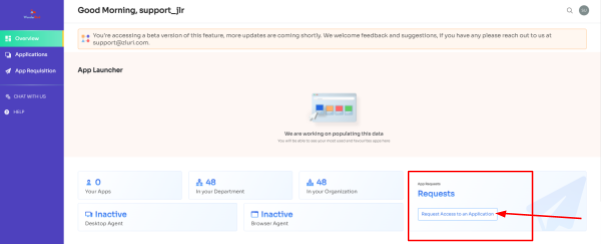
- Step 3: Your employees will see a dialogue box where they need to enter the application name they require access to. Then, click on Continue.

- Step 4: Some applications will not be used in the organization. However, your employees can still request that application. Click on continue, and another dialogue box will appear, showing similar applications that are being used in the organization.

- If your employees want to opt for a similar application, they can simply click on the application or click on Ignore and Continue to proceed forward with your request.
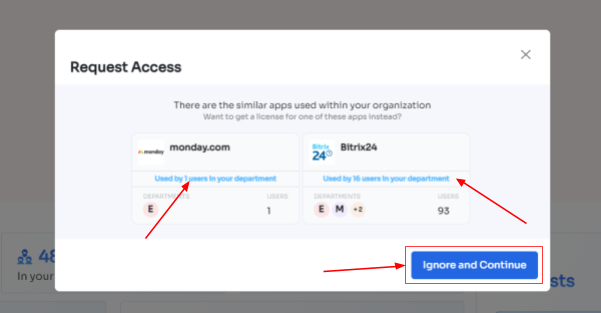
- Step 5: Further, they have to fill in the required details like selecting the license plan, subscription duration, and description of why they need the application and attach supporting documents. Once filled, click on Confirm request.

Note: Additionally, if the request has been modified in any way or if one of the approvers suggests any substitutes for the application, your employee can check it in the \"Changelogs.\"
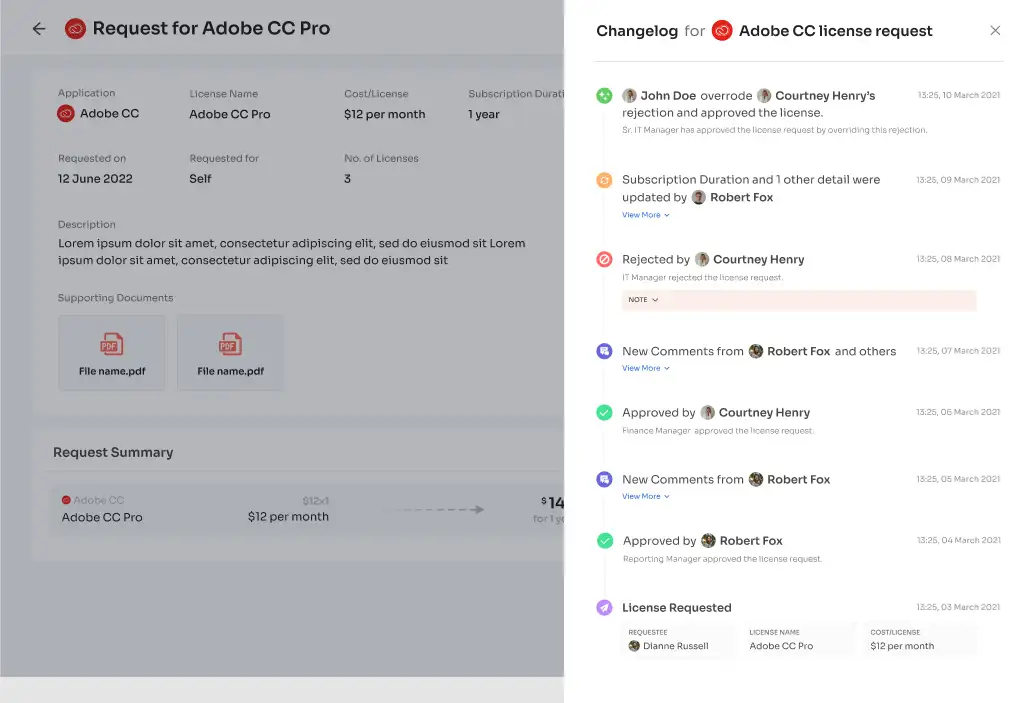
And that's it. The app access request has been submitted.
Enable Your Team To Securely Revoke Access During Offboarding
When employees leave the organization due to termination, resignation, or retirement, it is crucial to revoke all access promptly to prevent potential security breaches. Zluri comes to the rescue by enabling your IT admin to automate the deprovisioning process.
With Zluri, your IT admin can create an offboarding workflow that systematically revokes all access from departing employees. By automating this process, Zluri ensures that access to SaaS applications is securely and swiftly revoked, safeguarding sensitive data against potential cyberattacks.
So here are the steps that your team needs to follow to create an offboarding workflow:
- Step 1: From Zluri's main interface, click on the workflow module and select the offboarding option from the drop-down list. Proceed by clicking on New Workflow.

- Step 2: A popup labeled 'Select the user for offboarding' will appear. Select the employee(s) you want to offboard, or you can look for them in the 'search box. Click on continue after selecting the employee.

- Step 3: Your team will be able to view all the applications your employee can access. Now when you click on the app, Zluri will display some suggested actions under recommended actions. Select any of those or multiple actions, and then execute the required action for your chosen applications.
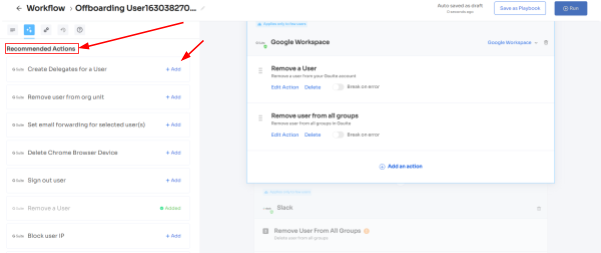
- Step 4: To add other actions, click Add an Action, fill in the required details, and proceed by clicking on Save Task; the actions will be saved.

- Step 5: Save the workflow by clicking Save as Playbook. A dialogue box will appear, instructing to name the playbook.

Add a name, click Save Playbook, and the offboarding workflow is ready.

So now you know why Zluri is the best of all; to learn more about it, book a demo now and give it a try.



Go from SaaS chaos to SaaS governance with Zluri
Tackle all the problems caused by decentralized, ad hoc SaaS adoption and usage on just one platform.
.webp)
















.webp)
.webp)





.webp)